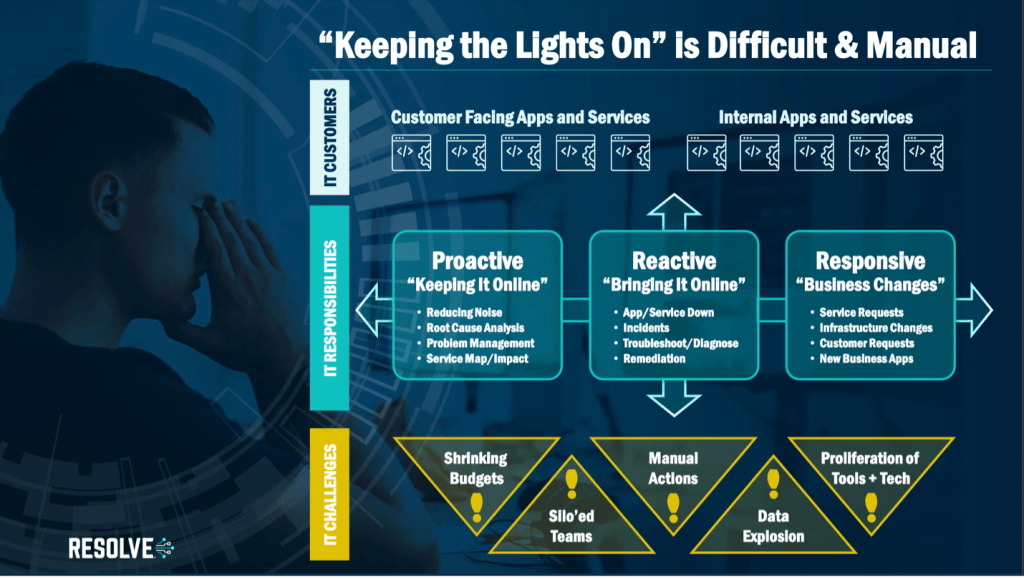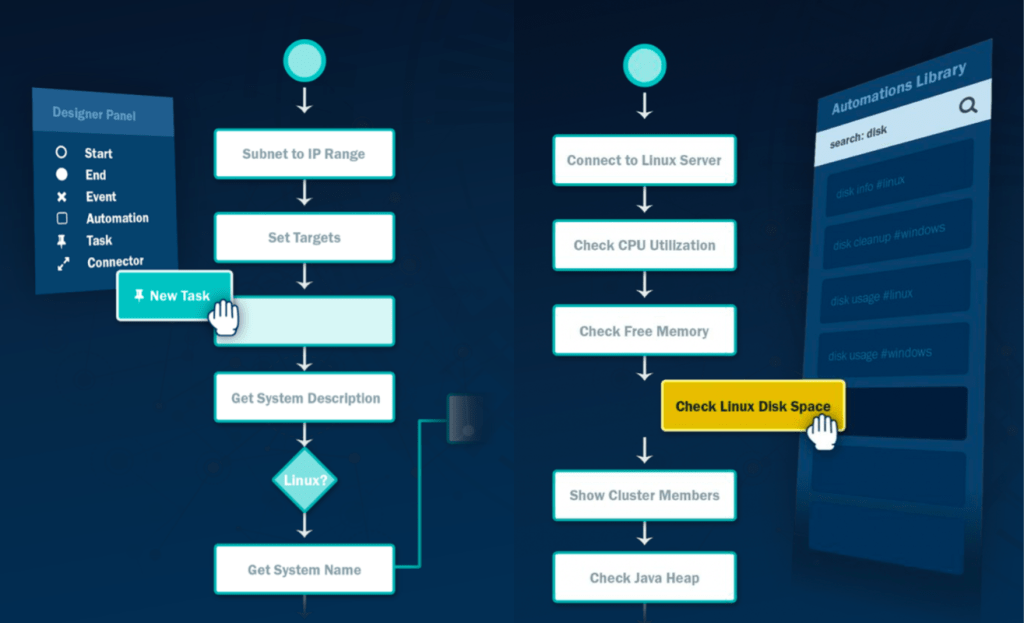
Optimize Your IT Service Management (ITSM) Investments with Automation!
Many companies invest in IT Service Management (ITSM) platforms to consolidate IT services into a single system, gain a real-time view of KPIs for IT teams & managers, and align IT services with business. IT Service Management platforms provide incremental value over time, so optimizing incident management in IT Service Management is an important step to explore. Ultimately, IT teams aim to verify, diagnose and resolve all incoming calls (calls) as soon as possible.
Interruptions in IT Processes Cause Major Losses
Considering the number of logs that organizations produce in a month, it is inevitable that events that affect the IT team and the customer will occur frequently. More than half of IT organizations identified as ready to support digital services encounter incidents weekly that also impact the customer. These events bring with them all kinds of complexity, from simple password resets to major service disruptions. It has been observed that while the events with little impact occur more than once during the day, IT events that we can count as relatively large occur once every two weeks in a significant part of the enterprises.
Downtime in mission-critical applications and systems can be dangerous. These events are;
- It hinders employee productivity.
- It interrupts business operations.
- It prevents businesses from meeting customer SLAs.
- It damages the brand value.
IT Service Management Helps IT Team Organize and Manage Incidents
IT Service Management platforms offer a quality toolkit for:
- Detecting events through a service portal,
- Capturing IT events on multiple communication channels,
- Viewing events, all IT tasks and projects in a larger context,
- Monitoring the event business status,
- Arranging various service-level commitments between providers and customers
- (in some cases) scheduling on call.
Essentially, IT Service Management circles an IT incident, connects the team, monitors and reports it to provide better performance for the entire IT operations organization. At first glance, it appears that the company’s event management needs are recorded by an IT Service Management. However, organizations; it aims not only to monitor and report daily events and complex events, but also to solve them in a faster, more reliable and less costly way.
Incident Resolution for Manual Processes is Critical!
IT incidents are usually resolved manually. This approach causes slowness and many dependencies. When attempting to verify, diagnose, or resolve an incident, the frontline agent or systems must switch directions between IT Service Management and other siloed systems. The results of commands are sometimes difficult to understand and activity data can be lost in the transfer between tools. Moreover, the first responders or systems often do not have permissions to log on to affected systems or take necessary diagnostic and remedial actions. This causes unnecessary escalations to Level 2 and beyond, even for relatively simple event types. A limited number of employees are expected to deal with further incidents. It is also a known fact that manual incident resolution invites human error.
Many IT teams do not have complete or up-to-date standard procedures for first responders to verify, diagnose, and resolve incidents. Even if they can interpret command results, the best previous decisions are their only guide. Because they are the least experienced members of an IT organization, they are unlikely to make the best decision to ensure the high quality or consistency required for robust incident resolution.
The Result: Higher Operating Expenses, Missed Opportunities and Potential Reputation Damage…
All these escalations place heavy burdens on the IT operation, the most obvious of which is increased operating costs. When a Level 2 agent or SME-Subject Matter Expert (database administrator, network engineer, system engineer, security expert, etc.) receives an escalation, take time to review the call and repeat the actions previously taken by the caller before continuing to advance the incident. should spend. Incidents resolved by level 2 cost approximately three times more than cases resolved by frontline agents. The cost of incidents resolved by top-level IT resources is equal to nine times the cost of an incident resolved by the frontline agent.
Beyond the calculable operational cost, escalated events also carry significant opportunity costs for the IT organization. Nearly 60% of organizations say incidents and outages cause IT disruption and distraction. This reduces Level 2 productivity as valuable staff members spend reactive, event-related time rather than value-added projects to support the wider business.
The consequences of slow incident resolution are felt across the entire enterprise. The longer a major incident takes to resolve:
- The longer and more serious the service impact, the greater the damage.
- Customer SLAs are more likely to be violated.
- An event that affects the customer has a negative impact on brand value and reputation.
For large incidents, it takes an average of half an hour for IT teams to assemble the right team members, and the average time to resolve major incidents is about six hours. As the severity of the event increases, these periods are also prolonged.
So How Does IT Automation Benefit Us?
Incident resolution is a valuable area to focus on improvements that will reduce manual effort, errors, and escalations. By quickly identifying service issues, quickly verifying, identifying and resolving IT incidents, organizations can greatly reduce legal and financial hazards.
As a result, customer satisfaction increases and other risks associated with infrastructure/service failures are reduced.
Well-implemented automation helps the organization manage an increasing number of systems and users without increasing costly staffing. The fundamental question on the minds of many IT operations leaders is:
“How do you approach automation for incident resolution?”
To answer this question, we need to understand the types of automation available and when and how to implement them.

Faster, Consistent Incident Resolution with Automation
Most people seeking enhanced IT incident resolution are positioning automation to replace human activities. This is often thought of in an end-to-end automation framework, where automation handles the event without any human intervention, from verification to diagnosis and resolution. While end-to-end automation can eliminate human error and speed resolution in certain types of incidents, IT teams need to speed up all events, even the most complex. This means that other key capabilities need end-to-end automation for maximum acceleration.
Implement an Appropriate Automation Strategy for Your IT Operations Team
IT incidents range from simple service requests such as opening an account to a user (server restart, password reset) to critical business service disruptions (virtual infrastructure, customer portal) that can involve multiple layers of application and infrastructure. A strategy is needed to accelerate all types of events.
End-to-end automation for simple incidents allows you to perform the entire resolution process with no human interaction. However, critical events affecting mission-critical systems cannot be easily resolved with end-to-end automation.
For critical incidents, IT teams should use automation to work with call managers to isolate and validate the responsible area across a broad technology stack. Complex events affecting mission-critical systems cannot be resolved with end-to-end automation.
How to Apply the Most Ideal Strategy?
The most effective method; will provide interactive procedures with call responders/managers that include targeted automations to assist in carrying out incident verification, diagnostics, and resolution activities.
An interactive procedure is a procedure that helps an agent troubleshoot and investigate a complex incident by asking questions and updating himself based on employee responses. In this way, employees can effectively direct the incident to a faster solution, in the right way.
Targeted automation is the opposite of end-to-end automation. Targeted automation empowers an employee to take care of a single task in the middle of a larger workflow to save manual hassle. The combination of these two capabilities means that any previously manual process can be modeled and accelerated.
Interactive Procedure: A procedure that is updated in response to an agent’s choices.
Targeted Automation: Automation where a single person focuses on a single task in the middle of a larger, people-oriented workflow.
End-to-end automation for simple incidents allows you to perform the entire resolution process with no human interaction. However, critical events affecting mission-critical systems cannot be easily resolved with end-to-end automation.
For critical incidents, IT teams should use automation to work with call managers to isolate and validate the responsible area across a broad technology stack. Complex events affecting mission-critical systems cannot be resolved with end-to-end automation.
Integrate Automation into Your IT Processes!
IT operations teams need an incident solution automation platform that can easily interoperate with existing IT systems and infrastructures. Resolution actions will likely involve making controlled changes to connected assets and systems to resolve identified issues and may require the platform to aggregate data from multiple IT management applications, CMDBs, network topology, and other tools to aid both human and automated decision making.
React Faster to Change!
In incident resolution, IT operations must be able to respond quickly to changes in infrastructure, applications, and business process services, as legacy procedures or automations can undermine quality.
The development of new automated processes is accelerated with a library of prebuilt automations that can be integrated into 3rd party systems. Because each organization’s environment is unique, non-developer SMEs must be enabled to quickly create and orchestrate automations. This not only saves IT operations from having to wait for support from an external software team, it is also a way for IT professionals to retain know-how.
Accelerate Incident Resolution with Resolve!
Resolve fully automates the verification, diagnosis and resolution of incidents wherever possible. When human intervention is required , Resolve provides interactive, context-specific procedures and built-in automations with frontline agents to reduce escalation to Level 2 or costly specialist staff (SME).
Resolve is preferred by the world’s leading organizations because it has the ability to keep up with the most demanding performance requirements. Resolve provides an integrated experience to make investments in IT Service Management beneficial.
To achieve fast time to value and fast time to market with new or modified automations, Resolve offers ready-to-use integrations into key IT systems with an extensive library of prebuilt automations and procedures for known event types. It also offers a low-code automation builder and drag & drop graphical interface for automation development and interactive guidance.

Conclusion
As incidents continue to pile on IT operations teams and impose huge costs on organizations, ITSMs intervene to help organize and manage the incident pile. IT leaders strive to resolve incidents faster and more efficiently, automation is key to this venture. Resolve complements IT Service Management and accelerates response to even the most complex IT incidents .
Share this blog post on social media!
Contact us for Resolve and IT Service Management Solution!


